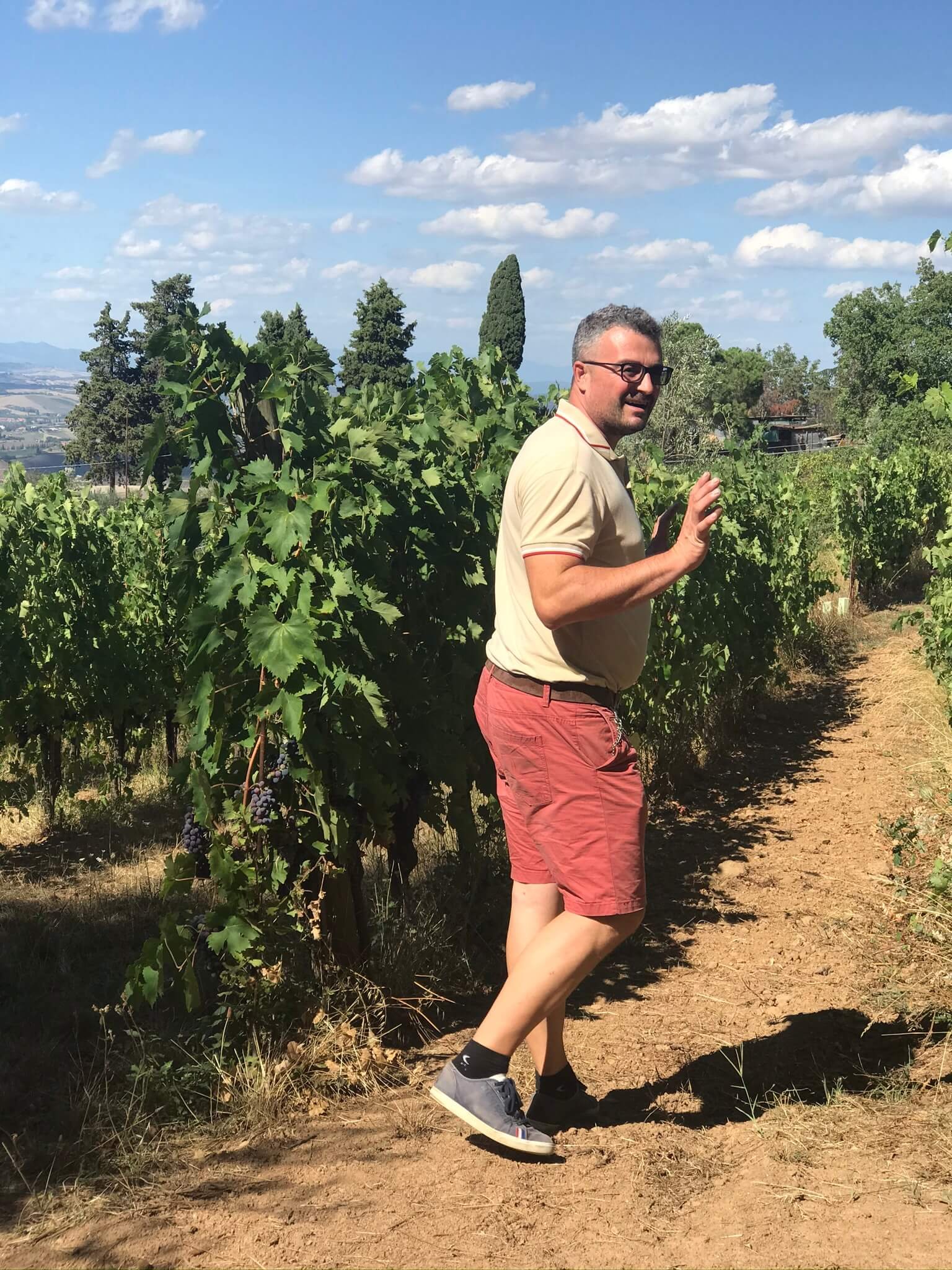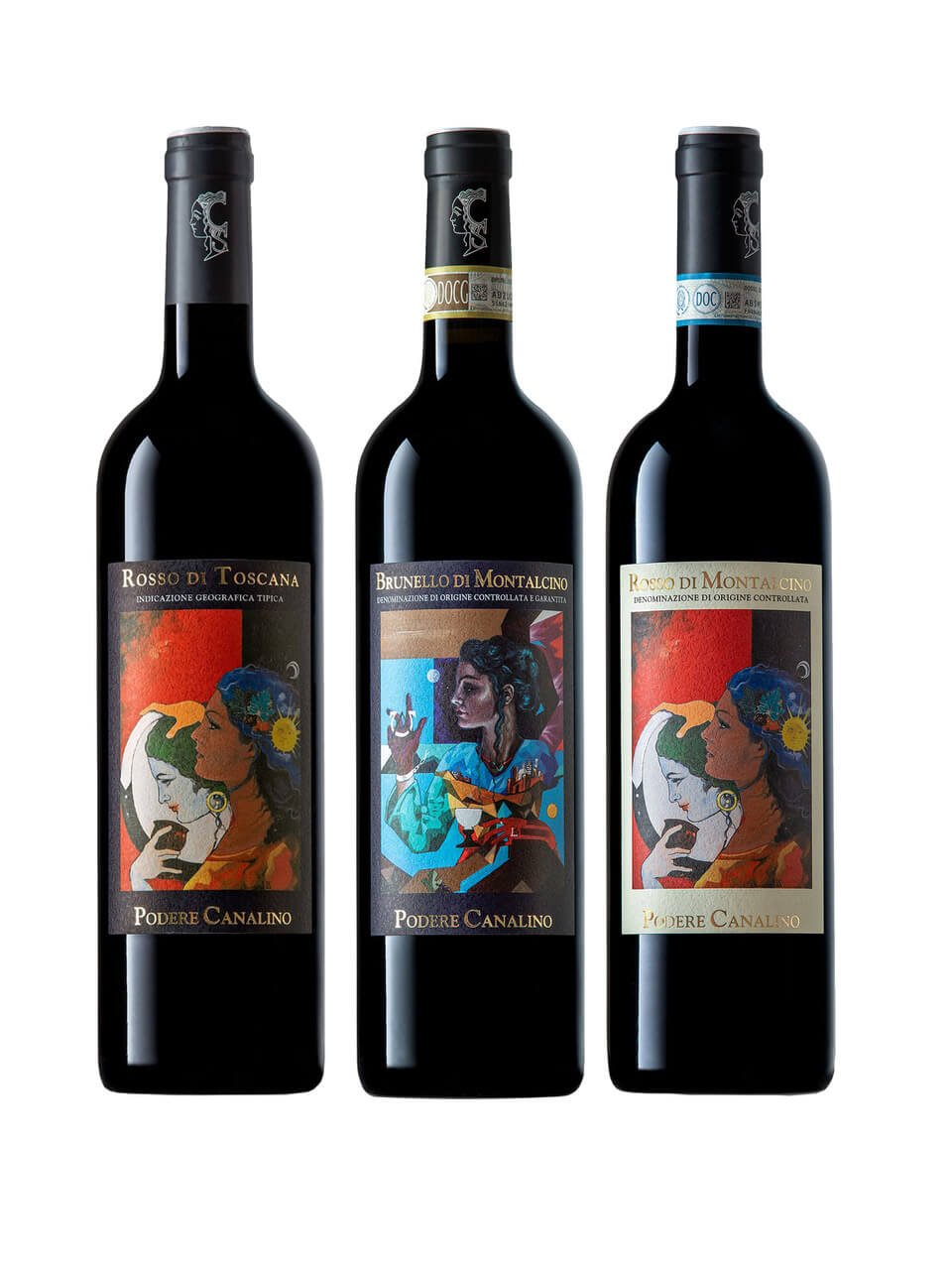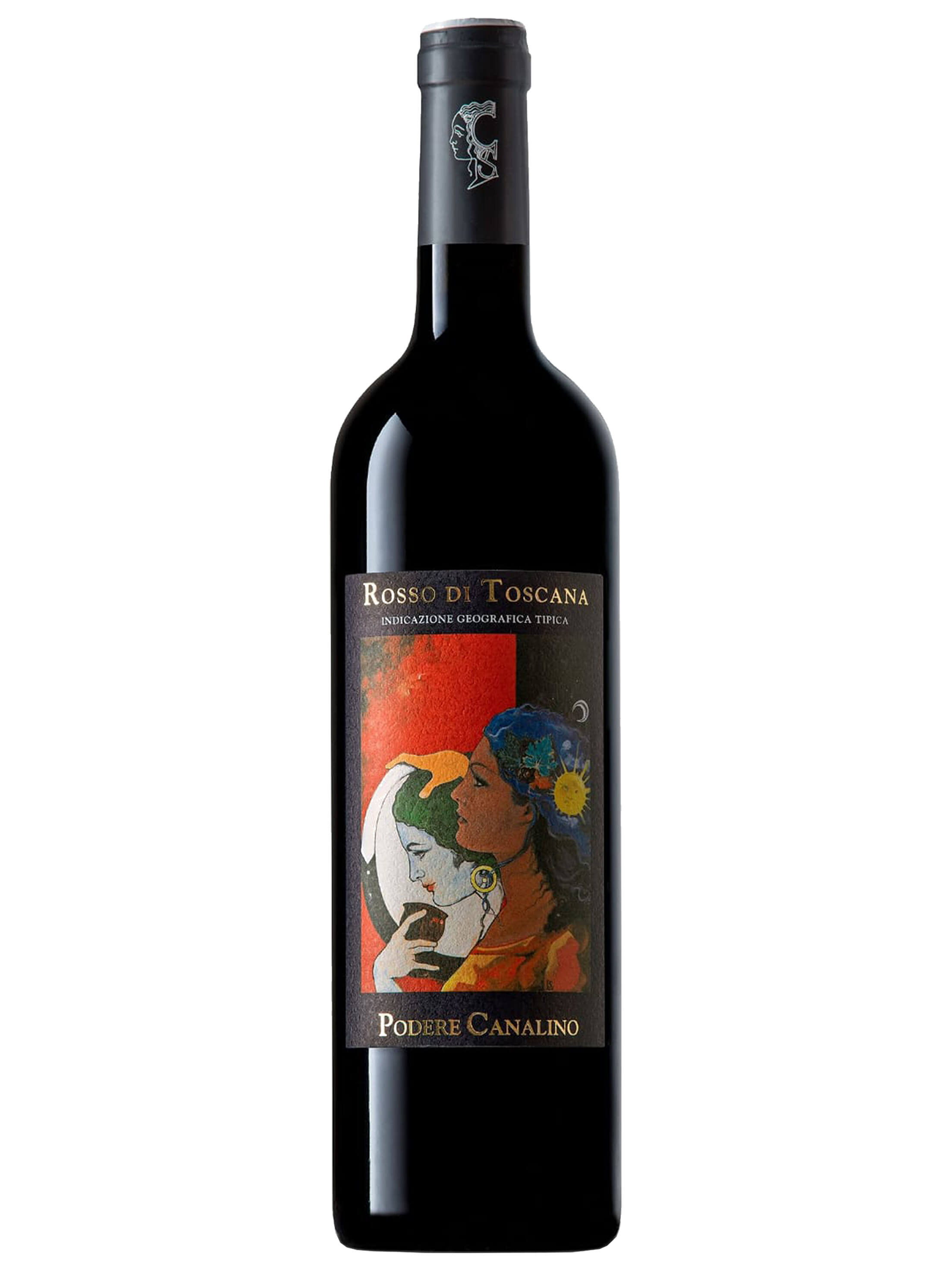A Winemaking Family with Deep Roots in Montalcino
In our last VeroTalk, we had the pleasure of having a fireside chat with Montalcino Winemaker Alberto Pagliantini about the fascinating centuries-long history of his family's estate winery Canalino while we also tasted his excellent wines. Moderator Alex Smookler, a Californian living in Montalcino with a travel design company, walked from Montalcino historic center to meet Alberto at his winery and vineyards right outside the north west Burelli Gate. Join us as we recap our delightful conversation with Alberto, about his family’s history with farming and wine, the essential role of biodiversity at the winery, why the location of the property is so great for winemaking, and the incredible dedication and hard work that goes into producing Alberto's wines.
Alex and Alberto enjoying a Tuscan charcuterie platter with Canalino red wines in front of a fire at Alberto’s winery.
Tell us about the history of the winery and how your family came to have this land.
The history of Canalino family estate winery is fascinating. Alberto shared that his family has been working the land for generations. His great-grandparents worked the land as sharecroppers. The nobles owned the land and allowed the family to live and work on it. They were permitted to keep a portion of what they produced, and the rest went to the nobles. In the 1900s, the system of mezzadria, or sharecropping, was terminated and tenant farmers, like Alberto's family, were able to buy the land they'd been working. Alberto's grandfather and his brother seized this opportunity and purchased the land where they and their parents had worked for decades. The land, therefore, came into the possession of Alberto's family.
The estate has gone through an evolution over the generations. Tell us about what was historically grown on the estate and why you switched to grapes.
Alberto's grandparents continued the tradition of their parents and mainly grew fruits, vegetables, and olives from which they would produce oil. They grew a small number of grapes and made some wine, but it was only a modest production for family consumption. As the farm passed on to Alberto's father, he continued to farm the land as his father and grandfather had done, but he had a passion for wine. The local wine business in Montalcino and the popularity of Brunello were also growing and gaining more and more international recognition. By 1999, Alberto's father decided to plant 11 plots of grapes, covering the majority of the property with vines. And in 2004, Alberto and his father released their first vintage on the market.
You didn't study winemaking at school – in fact, you studied something entirely different – tell us how you came to work at the winery.
After studying engineering at university, Alberto returned to help his father on the farm. When his father passed away, Alberto took over the winery. He now continues to operate the winery on his own. During critical periods of the year, including the harvest and bottling, family and friends come to assist Alberto, but it is a solo pursuit during the rest of the year. It's a testament to his dedication and passion for his wines as it is anything but easy work tending to the four hectares of land, the wine production, bottling, labeling, sales, marketing, and accounting. It's a one-person show, but he certainly wears a lot of hats!
The location of the winery is critical to its success. Why is the elevation of the winery so critical?
Alberto's winery is located at approximately 1150 feet above sea level and reaches almost 1400 feet above sea level at its highest points.
Alberto explained that historically there was a division of what was grown above and below 1000 feet. Grapes were grown above 1000 feet and grains below. This was because frost tends to occur in the low-lying valleys below 1000 feet. Grains are more frost-resistant. On the other hand, the vines are more fragile, and the frost, particularly in the spring, is a major risk once the vines have begun to sprout.
Nowadays, vineyards can be found both below and above 1000 feet. The vineyards below 1000 feet still struggle with frosts. For example, there were very low temperatures this last spring, and the producers had to create large fires between the vineyards to protect the plants from the frost. Many wineries lost grapes during the frost, but Alberto, fortunately, due to his location, was spared and didn't lose any grapes.
Alberto’s location is vital to his success not only due to the altitude but also because there is a natural spring on his property. How does the spring contribute to the winery's success?
The first is climate control. The spring remains at a near-constant temperature year-round of 12 degrees Celsius. In the winter, when it is cold, the spring helps to warm the environment, and in the summer, when it's hot, it does the opposite and provides a cooling effect.
The second role it plays is to provide water that's used during the production. When I visited the property right after the harvest, the new wine was in the large steel vats going through the first fermentation. The fermentation process causes the temperature of the wine to rise, but it mustn't go too high. To lower the temperature, Alberto ran a continuous stream of cool water from the spring over the outside of the steel vats until the desired temperature was achieved.
When you visit Alberto's winery, something you notice immediately is the explosion of bio-diversity. There are figs, cherries, apricot and peach trees, apple and pear trees, blackberries, jasmine, and more. Many wineries clear almost all other plants away from their property to plant as many vines as possible. You haven't done this; can you tell us why and what role the bio-diversity plays?
Alberto shared that he wants to keep with the tradition of the property which historically was used to grow fruits and vegetables. He has kept the other plants, and in turn, they provide two main benefits. The first is that they contribute to the wine's aromas and make for a more exciting and complex nose. Second, they provide a home for good bugs, which help to ward off destructive insects that could cause damage to the vines.
Alberto proudly giving a tour of his Sangiovese vineyards outside of Montalcino in Tuscany, Italy.
Talk to us about the harvest. Do you use machines to harvest or do you harvest by hand?
Alberto, following the tradition of his father and grandparents, harvests the grapes entirely by hand. The size of the land, the fact that it is uneven, and the small and tight space also make it impossible to harvest with machines.
You only grow one kind of grape – Sangiovese Grosso – so how do you decide which grapes will be used for which wines?
A few days before the harvest, Alberto walks the vineyards and decides which grapes will be used for each wine based on the quality of the grape, including how it's matured and the sugar levels.
For Brunello, only the vines that have been previously designated as Brunello vines and registered with the Consortium can be used to make Brunello. Occasionally, it will happen that there is a year with unfavorable conditions. Then Alberto can decide if he wants to forego making Brunello that year and instead use those grapes to make Rosso di Montalcino or Rosso di Toscana.
Once the harvest begins, there is an additional sorting and selection that happens in the field. Each bunch of grapes is examined, and any undesirable grapes or clusters, for example, dry or those that have not appropriately matured, are removed.
You've made an interesting decision to age all of your wines in oak – whereas the discipline only requires that Brunello is aged in wood. Why this preference for aging in oak?
To age the wines, Alberto uses large wooden barrels called botte in Italian. These barrels hold between 2000 and 2400 liters of wine. All of the botte that Alberto uses are neutral French oak.
Alberto's philosophy with Sangiovese is to be patient. He said that you can’t be fast and furious with Sangiovese. It needs time and wood to be able to express itself. That is why he ages all of his wines in wood. The Rosso di Toscana will spend several months in the wooden barrels. The Rosso di Montalcino will spend at least a year in the wood barrels but often longer depending on the vintage, and the Brunello as dictated by the discipline must spend at least two years in wood. Still, again Alberto often chooses to age it for longer. The result is especially noticeable in the Rosso di Montalcino, which is much more complex and persistent when compared to other Rosso di Montalcino.
How many bottles do you produce per year?
The annual production of the winery is on average 10,000 bottles per year.
Can you talk to us a little more about the Consortium, their involvement, and how it helps guarantee the quality of the wines?
As discussed in the first article of this series about Montalcino and the wines produced here, the Rosso di Montalcino and the Brunello di Montalcino are controlled by a Consortium. When the producers make these wines, they must follow a specific set of rules and regulations. Then before the wine can be sold on the market as Rosso di Montalcino or Brunello di Montalcino, the Consortium puts the wine through rigorous chemical testing and olfactory testing done by a sommelier panel. Only when the wine passes these tests will it receive the Consortium's stamp of approval and it can be sold as Rosso di Montalcino or Brunello di Montalcino. One of the most fundamental rules of the Consortium regarding Rosso and Brunello di Montalcino is that they must be made within the municipality of Montalcino.
How to Visit and Taste Canalino Wines for Yourself.
We had such a great time chatting and tasting with Alberto. He is such a warm and welcoming host, and we highly encourage you to go and visit him if you ever find yourself in Montalcino. You can easily visit his winery on foot from the historical center of Montalcino. It is just a 10-minute walk, out the Porta Burelli gate of the old town and down a gorgeous, panoramic road. We learned so much during our chat, and this article covers just some of the highlights. If you didn't see the live interview, make sure to go back and watch the replay, so you don't miss anything we discussed.
Finally, make sure to purchase Alberto's wine to try yourself. We thoroughly enjoyed the experience of trying his three wines, all made from the same grape – Sangiovese, side by side. It is fascinating to see the differences between the wines, even though they are all made from the same grape. It's also interesting to discover which wine you prefer. Although you would assume it will be the Brunello, we've found that everyone has their own favorite.
Buy the Montalcino Explorers Set of 3 wines and discover your favorite! Make sure to share with us on social which you prefer.
This article is written by Alex Smookler, founder and owner of Alex Smookler Travel, a Travel Design Company, who lives in Montalcino and who moderated our VeroTalk with Alberto of Canalino Estate winery.





